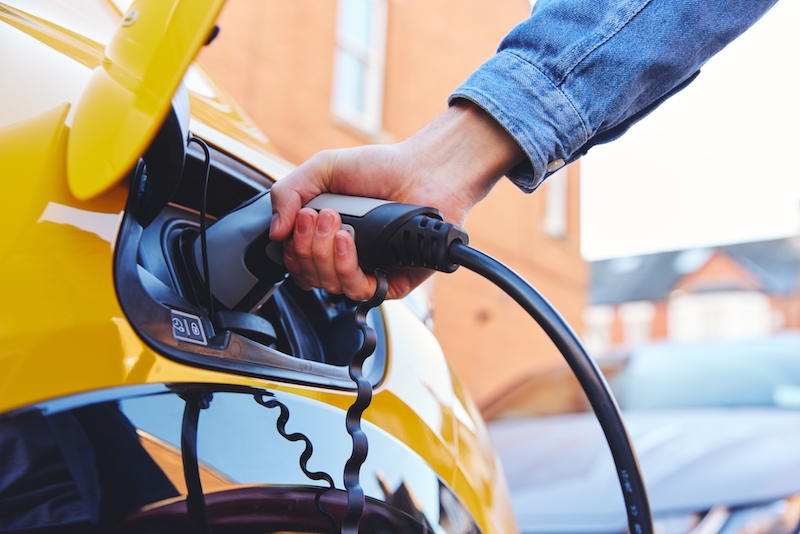The mainstreaming of EVs will impact everything from the air you breathe to the money you save, even if you don’t drive one.
By Courtney Lindwall, Natural Resources Defense Council
Electric vehicles (EVs) currently make up around 1 percent of all the cars, vans, trucks, and SUVs on the road in the United States. But that’s about to change. Last year, one in seven passenger vehicles sold around the world was electric. Car shoppers will soon have dozens of new electric models to choose from as automakers add more accessible options to their lineups. And a wave of states—including California, New Jersey, and New York—will phase out the sale of new gas-powered vehicles by 2035. Meanwhile, both the private and public sectors are racing to electrify their dirtiest diesel fleets, from semis to delivery trucks to city buses, in order to meet U.S. emissions reduction goals.
In other words: The EV revolution is upon us, and the benefits could be far-reaching—even for those of us who never plan to get behind the wheel of an EV. Here’s how:
1. Cleaner air and better health
Did you know that gas- and diesel-powered vehicles spew health-harming particulate matter into the air, causing tens of thousands of premature deaths in the United States each year? EVs, by comparison, produce zero tailpipe emissions. So the more EVs used across personal, public, and commercial transportation, the better the outcomes for our public health.
In California, the state with the highest number of EVs, residents are already starting to benefit. In a recent study focused on California’s EV transition, researchers found that increased EV adoption led to measurably improved air quality and fewer asthma-related hospital visits. Another study predicted that, by 2050, EVs would spare Angelenos alone an estimated $12.6 billion in annual related health-care costs. This kind of impact is particularly vital for low-income people and people of color, whose homes are more likely to sit next to freight hubs and within high-traffic corridors because of a long history of racist policies that used highways to segregate communities. As a result, those communities face compounding sources of air pollution, which result in lung and cardiovascular issues. Making EV adoption more affordable and charging infrastructure more widespread will also be important to this shift.
2. New jobs and economic growth
The EV revolution has the potential to create huge economic opportunities. Between 2020 and 2021, the number of EV jobs grew 26.2 percent in the United States, and a quarter of all announced global EV investments through 2030 are headed for the United States. But making the most of this rapidly expanding market will require investments at the local and federal levels as well as intentional policies and regulations.
Thankfully, there’s a combined $245 billion in federal EV investment from the Bipartisan Infrastructure Law and the Inflation Reduction Act. This funding is expected to spur domestic production of EVs and their batteries, as well as the construction of the nation’s charging network. Altogether, this will create tens of thousands of new high-quality autoworker, construction, and electrician jobs in communities across the country. In terms of regulations, the U.S. Environmental Protection Agency (EPA) has recently proposed federal clean car standards and clean truck standards covering semis and local delivery trucks. If the EPA adopts the strongest possible version of these standards by the end of the year, the United States would be on a path to ending tailpipe pollution, securing a once-in-a-generation opportunity to clean up our transportation system.
3. Lower utility costs
There’s a pretty straightforward explanation for how EVs can lower utility costs. One recent study looked at U.S. consumers’ electric bills in the service regions with the greatest number of EVs on the road. Researchers found that, between 2012 and 2021, EV drivers actually drove down electricity rates for all customers. That’s because people generally plug in their EVs overnight, when electricity demand (and therefore, pressure on the grid) is already low. Traditionally, utility companies would just pocket the extra earnings from these off-peak hours, but “revenue decoupling” policies can redirect these revenues to customers in the form of reduced bills. While these policies are not in place in every state, more and more are introducing them. This promise of cheaper electricity is especially good news for low-income U.S. households, who spend an average of 8.6 percent of their income on energy, nearly three times that of higher-earning households.
4. Quieter roads
Chronic noise pollution has been linked to stress, hearing damage, sleep disturbances, and even heart disease. And no one needs to tell you that combustion engines are notoriously noisy, particularly in congested cities and along highways. But compared to combustion-engine vehicles, EVs are nearly silent when traveling at low speeds. So quiet, in fact, that EV manufacturers install external speakers that produce noise when traveling slowly to alert pedestrians and others on the road. As EV adoption picks up, the rush hour soundscape will likely be far quieter—and more pleasant—than the one we hear now.

5. Climate benefits
Transportation makes up the biggest slice of U.S. greenhouse gas emissions, which means cleaning up the transportation system has a direct impact on climate. Already, driving an EV instead of a gas-powered vehicle in the United States cuts your climate pollution by about two-thirds over your car’s life span. But the emissions reductions from EV adoption will only increase as a larger percentage of our electricity is produced by clean energy and as battery technology improves, moving us that much closer to our goal of net-zero emissions by 2050.
Curbing climate change and ending tailpipe pollution is, of course, good news for everyone but especially for those in frontline communities, who are disproportionately affected. The litany of disruptive, dangerous, and costly climate impacts—from extreme storms to sea level rise—are already underway and threaten to get far worse. The EV revolution is fundamental to charting a different kind of climate future.
Originally published by the Natural Resources Defense Council and used with permission.





